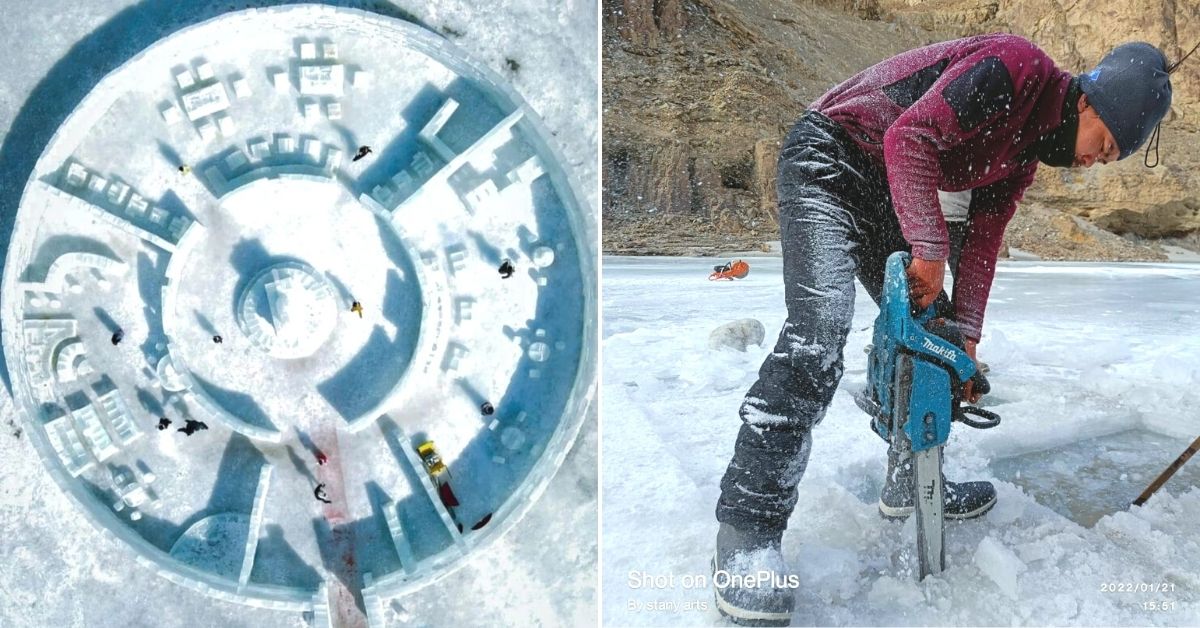In early 2018, over a span of 25 gruelling days, three Ladakhi artists — Tsering Gurmet Kungyam, Chemet Dorjay, and Stanzin Khangsar — came together to construct a Changchup Chorten (symbolising the Buddha’s moment of enlightenment). Located inside the Ice Stupa in Phyang village, located approximately 15 km from Leh, the 10-feet-high chorten was made entirely of ice. (Image above of the Ice Cafe in Chilling valley–aerial view–and an artist working)

Since then, these artists have gone on to make sculptures in the Leh market, and travelled across the world. They learnt the art of making structures from ice, like the Ice Hotel, in Jukkasjärvi, Sweden, attended international snow and ice festivals in China, and saw the potential of this art form in promoting winter tourism in Ladakh.
While it was just the three in the beginning, over the years, they have added more personnel. These young artists, largely in their 20s, include Stanzin Nurboo, Tashi Namgyal, Stanzin Wangyal, Stanzin Motup, Tundup Dorjay and Tsewang Gyaltson. On 23 December 2021, the group came together to establish the Kangsing (‘Snow Lion’, celestial animal of Himalayan region) Snow and Ice Sculpture Association.
This year, they organised the Ladakh Snow and Ice Sculpture Workshop 2022 in Chilling valley, along the frozen Zanskar River. This ‘first of its kind’ workshop was attended by 20-25 artists. Logistical support for participants came from the Ladakh Police, Ladakh Union Territory (UT) administration, Contractor Association of Ladakh, All Ladakh Hotel and Guest House Association, Department of tourism, and Ladakh Scouts regiment of the Indian Army.
While snow spraying guns and cutting machines are used to make these ice sculptures abroad, the first workshop concluded with traditional chisels, chainsaws, and other locally-made cutting machines.
Coming Together
“We brought together local graphic designers, traditional painters, artists, and sculptors who work on other mediums, and created a group called the Kangsing Snow and Ice Sculpture Association. In the past two years, we have seen what we need to help the practice of making ice sculptures flourish. During our visits to Sweden and China, we bought some smaller tools. However, we created our own ice-carving tool, akin to a wood-carving chisel, but only larger in size,” says Gurmet Kungyam, one of the region’s leading sculptors, speaking to The Better India.
When the local administration, which was focussed on the curbing the spread of COVID-19, was unable to come through to fund expensive artificial snow making equipment from abroad, the Kangsing Association sourced ice from the frozen Zanskar river in the Chilling area, used chainsaws to cut 15-20 kgs slabs of ice, and deployed their locally made chisels for carving work.
“We spent two months making these structures in Chilling alongside young artisans, many of whom were working with ice for the first time. We invited Lieutenant Governor RK Mathur [who heads the Ladakh UT administration] to our site. He spoke to us about the impact these ice sculptures could have on local winter tourism in Ladakh, an idea he had been thinking about for two years. He agreed to support our purchase of two snow making machines next year, and asked us to turn this into a self-sustaining endeavour,” recalls Gurmet Kungyam.
Meanwhile, Dr Nordan Otzer, a local social activist, who helped the Kangsing Association in organising the current workshops, spoke of the larger objective of this two-month workshop.
“In peak winter, when the temperatures go down to -20°C, traditional artisans who work with clay and ceramic are rendered jobless because their mediums freeze up. So why don’t we use this snow and ice to showcase their skills?”
He adds, “Some team members have visited countries like Sweden and China, where snow and ice festivals are conducted every year on an international level. This is happening for the first time in India. Even in the Himalayan belt, we have the potential to conduct events like The Harbin International Ice Festival in China, Sapporo Snow festival in Japan, and the Quebec City Winter Carnival in Canada,” he says.
In two months, the artists have made an ice cafe, a snow leopard (state animal) sculpture dedicated to the Ladakh Police, and items resembling interior (home) furniture.
Of their work and initiative, Gurmet Kungyam says, “We are artists. Having seen snow and ice throughout our childhood, we see its immense potential in constructing incredible works. Also, there is great potential for promoting winter tourism in Ladakh through these works of art.”
(Edited by Divya Sethu)
Like this story? Or have something to share? Write to us: contact@thebetterindia.com, or connect with us on Facebook and Twitter.
If you found our stories insightful, informative, or even just enjoyable, we invite you to consider making a voluntary payment to support the work we do at The Better India. Your contribution helps us continue producing quality content that educates, inspires, and drives positive change.
Choose one of the payment options below for your contribution-
By paying for the stories you value, you directly contribute to sustaining our efforts focused on making a difference in the world. Together, let's ensure that impactful stories continue to be told and shared, enriching lives and communities alike.
Thank you for your support. Here are some frequently asked questions you might find helpful to know why you are contributing?

